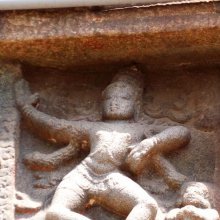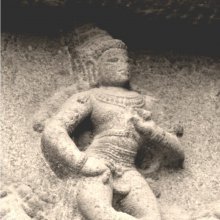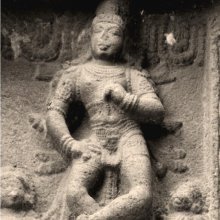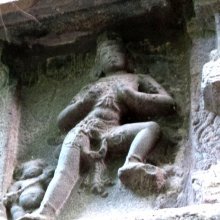Akuncita, Ākuñcita, Akumcita: 14 definitions
Introduction:
Akuncita means something in Buddhism, Pali, Hinduism, Sanskrit, Marathi. If you want to know the exact meaning, history, etymology or English translation of this term then check out the descriptions on this page. Add your comment or reference to a book if you want to contribute to this summary article.
Alternative spellings of this word include Akunchita.
Images (photo gallery)
(+1 more images available)
In Hinduism
Natyashastra (theatrics and dramaturgy)
Source: Wisdom Library: Nāṭya-śāstraĀkuñcita (आकुञ्चित) refers to a type of lying-down posture (śayana); it is a Sanskrit technical term defined in the Nāṭyaśāstra chapter 12. These postures are used when lying down in bed.
Source: archive.org: Natya ShastraĀkuñcita (आकुञ्चित).—A type of lying-down posture (śayana).—Instructions: Lying down with limbs narrowed down and the two knees sticking to the bed is called the Ākuñcita posture. It is to be used in representing persons attacked with cold.
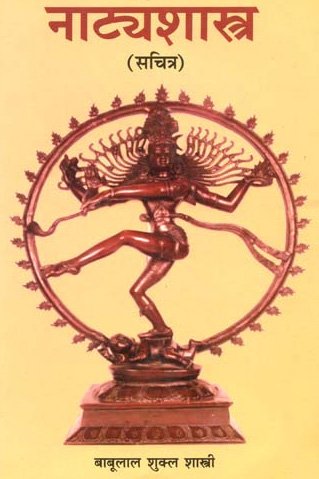
Natyashastra (नाट्यशास्त्र, nāṭyaśāstra) refers to both the ancient Indian tradition (shastra) of performing arts, (natya—theatrics, drama, dance, music), as well as the name of a Sanskrit work dealing with these subjects. It also teaches the rules for composing Dramatic plays (nataka), construction and performance of Theater, and Poetic works (kavya).
Yoga (school of philosophy)
Source: ORA: Amanaska (king of all yogas): A Critical Edition and Annotated Translation by Jason BirchĀkuñcita (आकुञ्चित) refers to “bending” (the two thumbs), according to the Mataṅgapārameśvaratantra (Mataṅgapārameśvara’s Yogapāda) verse 2.23-27.—Accordingly, while discussing ancillary and seated poses in Yoga: “[Having adopted either paryaṅka, kamala, bhadra or svastikāsana], the wise [Yogin] places his hands obliquely, in the middle of the shanks, makes [them] upward-facing and evenly balanced, and fixes the right hand on the left, so that the right fingers are at the base of the left [hand]. The two thumbs are bent slightly (kiñcid-ākuñcita) and should be held together. [...]”.

Yoga is originally considered a branch of Hindu philosophy (astika), but both ancient and modern Yoga combine the physical, mental and spiritual. Yoga teaches various physical techniques also known as āsanas (postures), used for various purposes (eg., meditation, contemplation, relaxation).
Shaktism (Shakta philosophy)
Source: Google Books: ManthanabhairavatantramĀkuñcita (आकुञ्चित) refers to “being bent (with shyness)”, according to the Kularatnoddyota, one of the earliest Kubjikā Tantras.—Accordingly, “[...] Now the goddess was troubled and her body was bent (ākuñcita) with shyness. (Thus her) form as the ‘crooked one’ came into being with (its) subtle, crooked limp but even then, the lord, blooming with joy, took the hand of the goddess and sat her on his lap. [...]”.

Shakta (शाक्त, śākta) or Shaktism (śāktism) represents a tradition of Hinduism where the Goddess (Devi) is revered and worshipped. Shakta literature includes a range of scriptures, including various Agamas and Tantras, although its roots may be traced back to the Vedas.
In Buddhism
Mahayana (major branch of Buddhism)
Source: Wisdom Library: Maha Prajnaparamita SastraĀkuñcita (आकुञ्चित) refers to “(that which is) folded”, according to Mahāprajñāpāramitāśāstra (chapter 2).—Accordingly, “[Question.—Why do Buddhist sūtras begin with the word evam, ‘thus’?]—[...] The believer says: ‘That is indeed so’ (evam etat). The disbeliever is like hard leather (gocarman) that cannot be folded (ākuñcita); the believer is like supple leather that can be folded for [any] use. Furthermore, it is said in a sūtra: ‘Faith is like a hand (hasta)’. Endowed with hands, the man who goes to a jewel mountain (ratnaparvata) gathers the jewels (ratna) at will. In the same way, the believer, penetrating into the Buddha’s doctrine – this jewel mountain that contains the pure faculties (anāsravendriya), the powers (bala), the path of enlightenment (bodhimārga) and the dhyānas—the believer, I say, is able to take [anything] he wishes. [...]”.
Source: De Gruyter: A Buddhist Ritual Manual on AgricultureĀkuñcita (आकुञ्चित) refers to the “coiled (body)” (of a Nāga), according to the Vajratuṇḍasamayakalparāja, an ancient Buddhist ritual manual on agriculture from the 5th-century (or earlier), containing various instructions for the Sangha to provide agriculture-related services to laypeople including rain-making, weather control and crop protection.—Accordingly [as the Bhagavān taught the detailed offering-manual], “[...] One should prepare a square [space] measuring a hasta, very smooth and well smeared. It should be sprinkled with perfumed water all around. Four Nāga kings should be prepared in the middle of the ditch. Full of brownish cow dung and clay a nine-headed [Nāga king should be prepared] with a hood and a coiled body (ākuñcita-śarīra). [...]”.

Mahayana (महायान, mahāyāna) is a major branch of Buddhism focusing on the path of a Bodhisattva (spiritual aspirants/ enlightened beings). Extant literature is vast and primarely composed in the Sanskrit language. There are many sūtras of which some of the earliest are the various Prajñāpāramitā sūtras.
Languages of India and abroad
Marathi-English dictionary
Source: DDSA: The Molesworth Marathi and English Dictionaryākuñcita (आकुंचित).—p (S) Contracted, closed, drawn up, in, together.
Source: DDSA: The Aryabhusan school dictionary, Marathi-Englishākuñcita (आकुंचित).—p Contracted; shrivelled up; narrowed.
Marathi is an Indo-European language having over 70 million native speakers people in (predominantly) Maharashtra India. Marathi, like many other Indo-Aryan languages, evolved from early forms of Prakrit, which itself is a subset of Sanskrit, one of the most ancient languages of the world.
Sanskrit dictionary
Source: Cologne Digital Sanskrit Dictionaries: Shabda-Sagara Sanskrit-English DictionaryĀkuñcita (आकुञ्चित).—mfn.
(-taḥ-tā-taṃ) 1. Bent, contracted. 2. Twisted, contorted. E. āṅ before kuci to contract, affix kta.
Source: Cologne Digital Sanskrit Dictionaries: Cappeller Sanskrit-English DictionaryĀkuñcita (आकुञ्चित).—[adjective] contracted, crooked, curled.
Source: Cologne Digital Sanskrit Dictionaries: Monier-Williams Sanskrit-English Dictionary1) Ākuñcita (आकुञ्चित):—[=ā-kuñcita] [from ā-kuñc] mfn. bent (as the arm or the knee, etc.), [Suśruta; Kumāra-sambhava iii, 70; Raghuvaṃśa] etc.
2) [v.s. ...] contracted (as the lips), [Rāmāyaṇa iii, 31, 21]
3) [v.s. ...] curled (as the hair), [Mahābhārata xiii, 882.]
Source: Cologne Digital Sanskrit Dictionaries: Yates Sanskrit-English DictionaryĀkuñcita (आकुञ्चित):—[ā-kuñcita] (taḥ-tā-taṃ) a. Bent.
Source: DDSA: Paia-sadda-mahannavo; a comprehensive Prakrit Hindi dictionary (S)Ākuñcita (आकुञ्चित) in the Sanskrit language is related to the Prakrit words: Auṃcia, Ākuṃciya.
Sanskrit, also spelled संस्कृतम् (saṃskṛtam), is an ancient language of India commonly seen as the grandmother of the Indo-European language family (even English!). Closely allied with Prakrit and Pali, Sanskrit is more exhaustive in both grammar and terms and has the most extensive collection of literature in the world, greatly surpassing its sister-languages Greek and Latin.
Kannada-English dictionary
Source: Alar: Kannada-English corpusĀkuṃcita (ಆಕುಂಚಿತ):—[adjective] shrunk; contracted.
--- OR ---
Ākuṃcita (ಆಕುಂಚಿತ):—
1) [noun] a particular manner of delivering a stroke in mace fight.
2) [noun] (dance.) name of one of the six reclining postures.
Kannada is a Dravidian language (as opposed to the Indo-European language family) mainly spoken in the southwestern region of India.
See also (Relevant definitions)
Starts with: Akuncitaka, Akuncitasharira.
Ends with: Avakumcita, Kincidakuncita, Nilakuncita, Samakuncita, Shikhakuncita, Sthitakuncita, Vyakuncita.
Full-text: Samakuncita, Vyakuncita, Aumcia, Akumciya, Sakuc, Sayana, Kuc, Kincit, Curving, Gocarman, Bodhimarga, Ratnaparvata, Anasravendriya, Carman, Kunc.
Relevant text
Search found 2 books and stories containing Akuncita, Ākuñcita, Akumcita, A-kuncita, Ā-kuñcita, Ākuṃcita; (plurals include: Akuncitas, Ākuñcitas, Akumcitas, kuncitas, kuñcitas, Ākuṃcitas). You can also click to the full overview containing English textual excerpts. Below are direct links for the most relevant articles:
Natyashastra (English) (by Bharata-muni)
Maha Prajnaparamita Sastra (by Gelongma Karma Migme Chödrön)
Part 1 - Explanation of the word ‘evam’ < [Chapter II - Evam Mayā Śrutam Ekasmin Samaye]
